Choose Your Activity
Choose Where You Sleep
- Aurora
- Mermaid I
- Ondina
- Raja Ampat Agressor
- Tambora
Indonesia Snorkeling
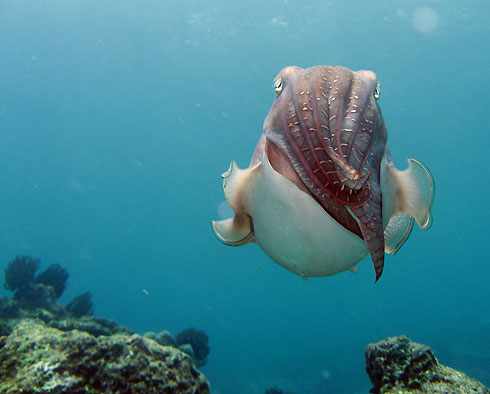
Choose where you sleep
- Aurora
- Mermaid I
- Ondina
- Raja Ampat Agressor
- Tambora
The Spice Islands, famous for their cloves, nutmeg and stories about Buginese pirates, offers diving encounters of extraordinary diversity. Within the intense blue of the Banda Sea, steep pinnacles raise from the ocean floor creating islands that harbour emerald-green lagoons filled with sand produced by the erosion of corals (coral cays) colonised by a rich vegetation.
The distinctive feature is the crowding marine life found around the pinnacles rising almost vertically from abyssal depths: Gunung Api, Lucipara, Bandaneira are all coral formations decorating the top of volcanoes. Each one has its own features and phenomena, like the extraordinary crowd of sea snakes.
Unlike other areas, with high populations and subsequent pressure from fishing, the Bandas' relatively small human population has been a blessing for divers - offering a vibrant, healthy reef system with fish life in incredible numbers along with huge gorgonians and sponges and some truly monumental hard corals.
Diving in the Spice Islands, expect plenty of pelagics, widespread muck diving and unexplored coral gardens, as well as a rich colonial heritage on land.
Cruises that take in the Banda Sea, often start or end at the famous port of Ambon, offering the chance to dive with the unusual critters of Ambon Bay. Other pass through sizing between Sorong in West Papua and Bitung or Manado in North Sulawesi, offering diving in the famous sites of Raja Ampat and/or the Lembeh Strait, respectively.
Tambora
The Spice Trail
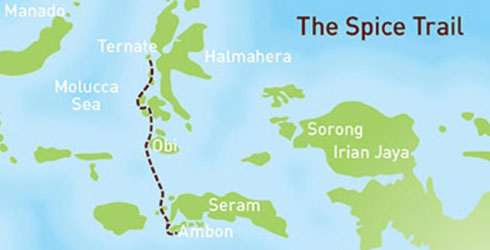
The Spice Trail, new for 2015, takes in the best of both northern and southern Maluku, venturing from Halmahera to the spice islands of the Banda Sea and ending up in Ambon... another muck diving mecca. - See more at: http://symbiosis-travel.com/indonesia/dive-liveaboards/257/north-maluku-dive-cruises/#top
The Spice Trail, new for 2015, takes in the best of both northern and southern Maluku, venturing from Halmahera to the spice islands of the Banda Sea and ending up in Ambon... another muck diving mecca.
Journey in Time - From Ambon to Triton Bay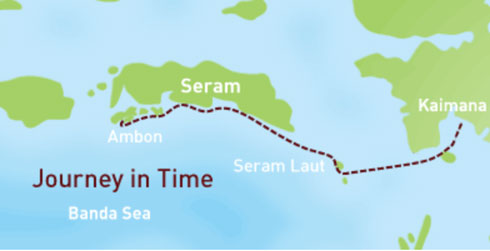
The cruise takes Tambora from Ambon, the modern-day capital of Maluku (the Moluccas), through the Seram Laut group, now forgotten by the world but powerful trade ports 300 years ago, to the south coast of West Papua with its characteristic ancient rock paintings.
Tabora will start off this cruise with some much diving in Ambon Bay, producing many a photographer’s dream specimen, including many varieties of frogfish, the elusive ghost pipefish, and mandarin fish.
Dive the South coast of Ambon with its cavernous walls, the Lease Group and the South coast of Ambon with lots of big fish action, then arriving to Seram Laut. Here, strong currents and up-wellings from the depth produce an incredible richness of fish, including barracudas, giant trevally, dogtooth tuna, and mantas, among many others.
Leaving Seram Laut, Tambora will continue eastwards to the Papua coast. The limestone cliffs here served in ancient times as burial grounds, and are decorated with galleries of rock paintings. Below the sea, adjacent Triton and Aetna Bays boast some of the world’s most amazing coral gardens, alive with the world’s most diverse assortment of reef fish! Each cruise will include some all-time favourite sites as well as some exploratory diving. In some spots, you might very well be among the first ever-divers in the water!
You will disembark in the picturesque little town of Kaimana, with flight connections to Sorong, Manado, Denpasar and Jakarta.
Sapphire Seram Sea - From Raja Ampat via the Banda Sea to Ambon
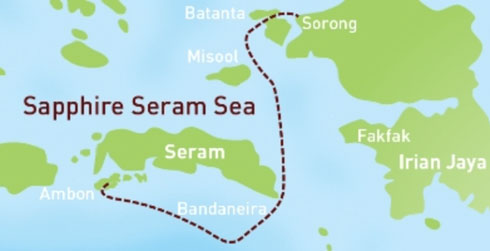
This 13 day/12 night cruise departs from Sorong, the main starting point for diving cruises to Raja Ampat, and arrives in Ambon, capital of Maluku (the Moluccas).
The Tambora will sail out of Sorong and head straight to the Sagewin Strait for a day of critter diving in the many bays along the South shore of Batanta, one for the four kings that make up Raja Ampat. After an overnight sail south, she will arrive in the labyrinth of islands, islets and rocks east of Misool. Here, she will spend a couple of days diving what are widely recognised as the world’s most prolific coral reefs. Big schools of reef fish as well as manta rays are also often sighted in the waters around Misool.
Another southbound overnight steam will take the Tambora to Koon Island, in the Seram Laut group; here, strong currents from the depth create an environment that attracts feeding fish, big and small.
The Banda archipelago, a volcanic mini-archipelago rising out of 5,000m of water, is the next stop. You will be diving along the walls at the outer edge of the caldera, on the lava flow from the most recent eruption which has since been covered by a vast field of cabbage coral, and right in the centre of the protected lagoon to check out mating mandarin fish. Some of the best muck diving in the country, right in Ambon Bay, will round things up on the day prior to disembarkation.
Access to Sorong, Tambora’s port of embarkation, is easiest via Jakarta, Manado and Ambon. Upon arrival in Ambon, you can catch an onward flight to many destinations across Indonesia, or stay on for a couple of days to take in the varied cultures and sights of central Maluku.
Planet Pelagic - Across the Banda Sea
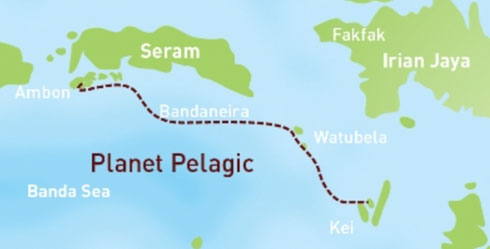
This incredible 12 night cruise takes Tambora through the best parts of the Banda Sea, from highlight to highlight. Due to seasonal constraints, it can be conducted only within two narrow time windows. So book early!
Start things off with some great muck diving right in Ambon Bay, only minutes away from Tambora’s point of departure. Next day, sail along the south coast of the island, diving cavernous walls with healthy soft coral coverage. From here, proceed to the Lease group east of Ambon, diving the islands of Molana and Nusa Laut.
After on overnight journey, Tambora will reach the Banda islands, a volcanic mini-archipelago rising 5,000m from the sea bed. Dive Westernmost Run and Ai islands prior to entering into the lagoon where Tambora will drop anchor. From this base, dive a line-up of world-class sites nearby.
Spend 2-3 days here prior to sailing further east, diving Hatta and Karang Hatta on the way, to the fabled islands south east of Seram, collectively know as Seram Laut. Here, strong currents and up-swellings from the depth produce an incredible richness of fish, including barracudas, giant trevally, and dogtooth tuna among many others.
From Seram Laut, Tambora will sail south towards the Kei archipelago, known for its leatherback turtles. Thanks to its isolated setting, the Kei group is rarely visited or dived, hence our visit will invariably encompass some exploration diving.
On day 13 we will pull into Tual, the main city in the Kei Islands group, from where you can catch your flight back into Ambon.
The Blue Asylum - Dive the crystal clear waters of the Southeastern Banda Sea
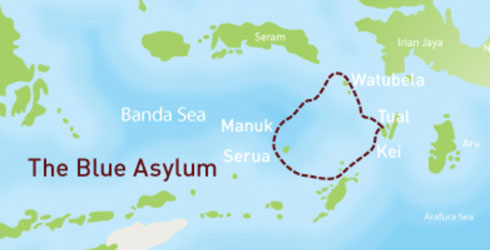
Tambora’s cruise, ‘The Blue Asylum’, starts and ends in Tual, the main port of the Kei Islands in the Southeast Moluccas (Maluku). At the time of the year we are sailing this route, the water is typically crystal clear, providing the ideal setting for wide angle underwater photography.
Over the course of this 12D/11N cruise, the Tambora will sail a circular itinerary through the southeastern Banda Sea surrounding the Kei Islands. Spectacular diving on some of the most extensive and intact coral reef systems in Indonesia, often steep walls but also some gentle sloping formations. Fish life is abundant, with large schools of reef fish as well as frequent sightings of larger pelagic species, including big schools of yellowtail and grey barracuda, giant trevally, dogtooth tuna, white and black grey reef sharks, thresher sharks, huge napoleon wrasses, as well as massive clouds of fusiliers streaming up and down the walls and slopes. Some dive sites on Tambora’s itinerary are beautifully covered in the most colourful soft corals, others boast large overhangs, cracks, caves and other stunning underwater formations. What’s more, there are also many rare critters to be found, including various types of ghost pipe fishes and some rare nudibranches.
In spite of its rather remote location, access to Tual is surprisingly straightforward, thanks to twice daily flights to and from Ambon that connect to a number of different locations across Indonesia including Jakarta, Denpasar, Makassar, Manado and Sorong.
Colours of Kei - Eastern Banda Sea & Triton Bay
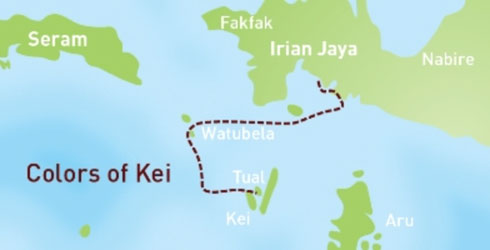
The cruise ‘Colours of Kei’ combines two dive regions that are both world class but very different one from another: the chain of islands at the eastern border of the Banda Sea; and, Triton Bay, just off the Papuan mainland.
Tambora’s cruise commences in Tual, the main city in the Kei Islands group which are known for their large population of leatherback turtles. Soon upon leaving Tual, you will start diving the many surrounding islands and islets; some of the diving here still has exploration character since the area is very rarely visited let alone dived. Moving north, you will next dive the Watubela chain of islands; here, crystal clear water, steep walls, and some of the most amazing table coral gardens await. When the currents are running, there is a fair chance of seeing batteries of barracuda and the biggest Napoleon wrasses found anywhere!
Leaving the Moluccas, Tabora will cross over to the Papuan mainland and Triton Bay to experience a very different scenery both above and below the waterline: densely forested mountains, their peaks more often than not veiled in clouds, make a dramatic backdrop to underwater slopes alive with the most delicate and colourful soft corals over which big schools of fish are feeding and hunting. Given the close proximity to the mainland, visibility varies significantly, and we will need to select our sites and time our dives with this in mind.
On the day prior to disembarkation, visit the huge limestone labyrinth inside the bay before pulling into Kaimana. From here, you can continue to Ambon, Sorong or Jakarta. Tual, the port of embarkation, can easily be reached by plane from Jakarta or Ambon.
Great Eastern Arc - From South Raja Ampat via Seram Laut and Watubela into Kei
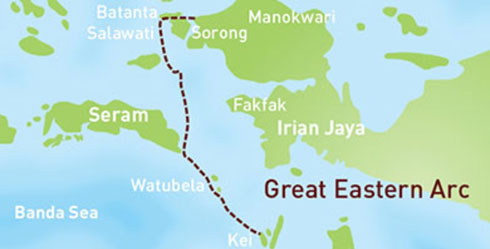
Tambora’s itinerary, ‘Great Eastern Arc’, combines two world class dive regions in a single cruise: the Southern islands of Raja Ampat and the Eastern rim of the Banda Sea. Both areas have their own unique attractions, and hence this itinerary offers some of the best diving in the country along many different dimensions.
Upon leaving Sorong, our first stop is at the Southern shores of the island of Batanta, one of the 4 Kings comprising Raja Ampat. Dive a series of black sand bays, a prime habit for critters like nudibranches, ghost pipefish and seahorses. Next, an overnight passage brings Tambora to the karst island-dotted seascape lying to the East of Misool. Over the next couple of days you can sample some of the best dive sites in all of Raja Ampat, with brilliantly coloured soft corals and myriads of schooling fish.
From Misool sail across the Seram Sea to reach the small island of Koon in the Seram Laut Group. Here, strong currents from deep create an environment that attracts feeding fish, big and small.
Continuing on further south along the Great Eastern Arc, Tambora will reach the Watubela chain of islands. Crystal clear water with 40m + visibility, steep walls, stunning underwater rock formations, and some of the best hard coral gardens await us here. What’s more, large batteries of barracuda and big gatherings of Napoleon wrasses are also among the highlights of diving Watubela.
The night before disembarkation, the Tambora we will pull into Tual harbor, from where you can catch your flight back into Ambon and onwards across Indonesia.
Ocean Rover
Ocean Rover periodically leaves its main diving grounds of Raja Ampat, on the west tip of Papua, and the Komodo National Park to explore the hidden islands of the Banda Sea. Access is via Ambon.
Aurora
The Spice Islands, that have become famous for their cloves, nutmeg and historical stories about pirates. From the intense blue Banda Sea, steep pinnacles pierce the surface, surrounding them surreal emerald-green lagoons and islands made from coral sand. These aptly named Coral Keys and are colonised by rich vegetation.
The landscape and coral islands alternate with rock formations covered with a blanket of green vegetation, giving our passage from Asia to Oceania an almost unreal magic. We refer here to biological borders that sometimes are quite different from geographical borders. The dry season starts in this region in September and goes until end of March; however, rainfall can be expected throughout the year.
Around and in the middle of the Banda sea, the crests of the submerged pinnacles are surrounded by a magnificent reef, at times very rich of hard corals.
Aurora will sail around several islands, including Gunung Api, Lucipara, and the islets around Banda, until the waters of Ambon. She will overnight almost every day in a different bay.
Mermaid
Spice Islands: Maumere-Banda-Raja Ampat Biodiversity Cruise
Where to start when the whole trip is one big highlight? On the crossing from Flores to West Papua via the Banda Sea we dive colourful reefs, pinnacles, walls, caves and swim-throughs, mangroves, limestone, volcanoes, hot springs. Fish-wise we encounter Hammerhead, Grey Reef and Wobbegong Sharks, Snakes, Pygmy Seahorses, massive schools of Barracudas, Trevallies, Batfish and billions of Red Tooth Trigger as well as Pyramid Butterfly fish.
In Banda Neira, the former global center of the nutmeg trade, we visit the local museum and a nutmeg plantation, walk around the small town and admire all the beautiful old Colonial buildings. The view from the old fortress is breathtaking as well!
Continue the 15 day long dive trip towards Raja Ampat, where can enjoy beautiful soft coral reefs with vibrant colours. Oceanic Manta Rays circle, Pontohi and Bargibanti Pygmy Sea Horses are playing peekaboo sitting in their fans. An exceptional trip!
Ondina
Alor Straits, Inner seas islands & Tanimbar
The Forgotten islands in the Banda Sea, Ambon
The Aurora
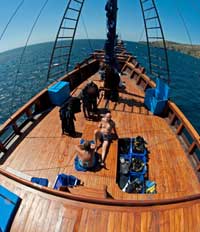 The MSY Aurora is a twin mast motor sailor, constructed from teak in the traditional “Pinisi” style, and designed for a demanding clientele of diver looking for a high standard of comfort.
The MSY Aurora is a twin mast motor sailor, constructed from teak in the traditional “Pinisi” style, and designed for a demanding clientele of diver looking for a high standard of comfort.
Utilising modern and environmentally friendly operating principles, the Aurora offers scuba safaris to some of the World's richest marine environment all around Indonesia.
The construction of Aurora began in December 2007 at a traditional shipyard in South Sulawesi, and she was launched in the summer of 2009.
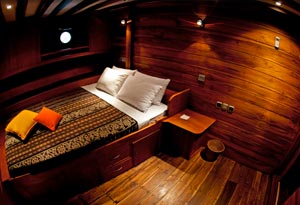 All cabins have individually controlled AC, en-suite bathroom and shower. There is a saloon/restaurant with library, computer room/study room with PC, DVD, video, photo, recharging batteries, and a spacious sun deck.
All cabins have individually controlled AC, en-suite bathroom and shower. There is a saloon/restaurant with library, computer room/study room with PC, DVD, video, photo, recharging batteries, and a spacious sun deck.
Technical data
- Overall length: 42 m
- Width: 9 m
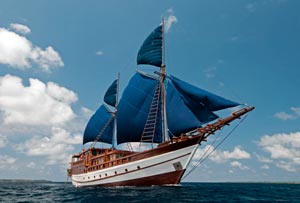 Tonnage: 75 tons
Tonnage: 75 tons- Sailing surface: 300 m2
- Power: 1 engine: Nissan 420 HP, cruising speed: 8-10 knots.
- Accomodation: 7 double cabins of which 3 dispose over a third bed.
- All cabins have individually controlled AC, ensuite bathroom and shower.
- Stairs on both sides lead to the diving tenders
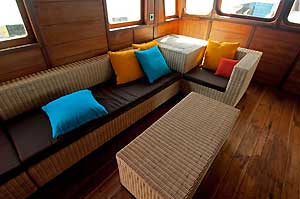 Saloon/restaurant with library, computer room/study room with PC, DVD, video, photo, recharging batteries
Saloon/restaurant with library, computer room/study room with PC, DVD, video, photo, recharging batteries- Open sitting corner at bow; the roof of the restaurant is a very spacious sun deck.
Equipment on board
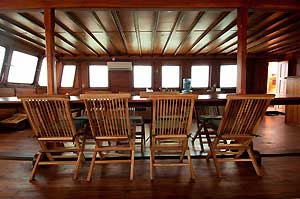 GPS, radio, sat-phone, echo sounder
GPS, radio, sat-phone, echo sounder- 2 generators for 220 V in each cabin (2-pole plug, without the third earth pole – like in continental Europe)
- 2 compressors for air, 1 compressor Nitrox
- 3 tenders for each 8 persons
- water maker 6000 ltr/ day
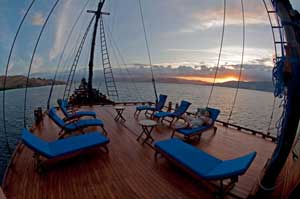 Safety devices
Safety devices
- First Aid kits
- emergency oxygen
- manual fire extinguishers
- 406 EPIRB – Emergency Position Indicating Radio Beacon
- life vests for all passengers including crew members
- 2 life rafts
- Sailing surface: 300 m2
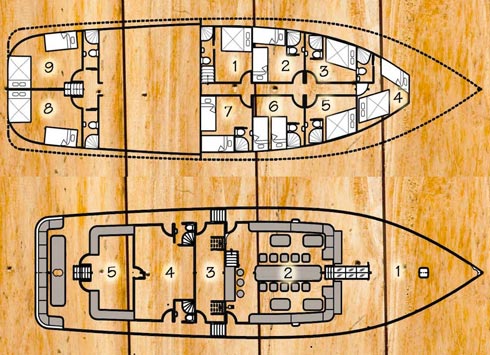
Top: Cabins
Bottom:
1- foredeck, preparation area for scuba diving
2- Restaurant/bar
3- Captain’s bridge
4- Diving equipment/compressors/ laboratory
5- Lounge/photo/video area
The Mermaid I
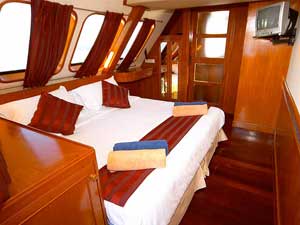 M/V Mermaid I is a 28 metre, twin-engined steel motor yacht. She comfortably holds 15 guests in 1 Master State Room (king bed), 1 Single and 4 Deluxe Cabins (double or twin beds) and 2 Budget Cabins (double/twin beds) below deck.
M/V Mermaid I is a 28 metre, twin-engined steel motor yacht. She comfortably holds 15 guests in 1 Master State Room (king bed), 1 Single and 4 Deluxe Cabins (double or twin beds) and 2 Budget Cabins (double/twin beds) below deck.
The master, single and deluxe cabins have ensuite bathrooms, refrigerator and panoramic sea view windows. The budget cabins are below decks with ensuite bathroom and refrigerator. All cabins have TV and DVD access, bathrobes and toiletries and loads of fluffy towels.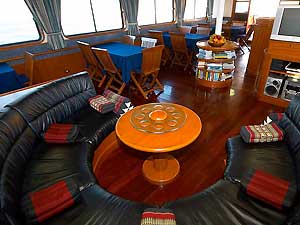
The large, purpose-built dive deck and wide stern dive platform with two exit ladders and fresh water showers are perfect for diving. 4 camera rinse tanks ensure your valuable equipment is well looked after.
Thai and western meals are served in the Sawasdee Restaurant, equipped with large windows to enjoy the views. After meals, you may relax in the saloon, equipped with 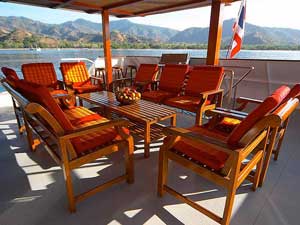 TV/DVD and music center, and an extensive library and full range of marine life books.
TV/DVD and music center, and an extensive library and full range of marine life books.
There are two outside decks, one shaded with outside seating and one sundeck with sunshade and cushioned sun beds. NITROX is available on every cruise.
Boat Information
- Name : Mermaid I
- Destination : Indonesia
- Seasons : June to October
- Capacity : 15 guests (max no. guests)
About the cabins
-
Cabin Facilities Rooms: 3 double beds 4 twin sharing, 1 single with private bathroom, Showers & toilets, Hot Water, TV, video and stereo.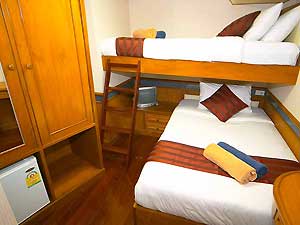
- Ele ctricity : 220V
- Sockets:
Technical Data
-
Length x Beam : 28 m / 94 feet,7 m / 21 feet.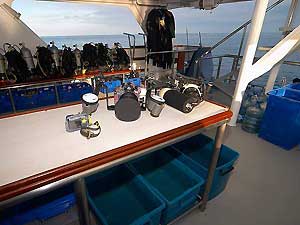
- Engines : 2x 450 HP
- Max speed : 12 knots
- Cruising speed : 9.5 knots
- Navigation equipment : GPS and radar for safety and ease of navigation.
- Communications equipment : VHF and SSB radios, a satellite phone, plus mobile telephone communications equipment.
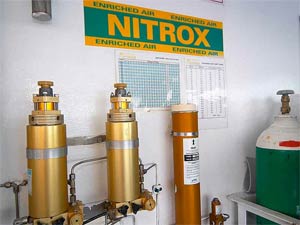 Fuel capacity : 18,000 Litres
Fuel capacity : 18,000 Litres- Fresh water capacity : 20,000 Litres
Further Information
- Dive Entry : platform or dinghy
- Life jackets : yes
- Life rafts : Yes
- Boat Crew :

New:
1. Membrane System
Filling at 600 litres a minute equals fast turn arounds and unlimited nitrox available for all divers - no matter your destination or tank size - 12 litres or 15 litres - your choice!
2. More Camera Tables!
The membrane system means lots of extra deck space so more good news - 2 extra camera tables have been added and fresh water rinse containers... masses of room for all photographers on board. Plus added shelving for guest's to keep their small items close to hand on the deck...
3. Warm deck towels
Towels straight out of the dryer after each dive - just heaven!
4. Kayaks
For those who want to relax on the quiet waterways around Komodo and Burma, Mermaid now has some kayaks on board for those with a spirit of adventure.
5. How do you like your eggs?
Cooked to your specification in the saloon and served piping hot - as one would expect from any 5 star service!
The Ondina
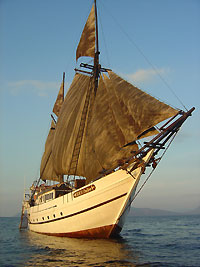 SMY Ondina is a traditional "Pinisi" style sailing schooner that has been beautifully restored to a high level of comfort and is fully equipped for dive safaris in the Kommodo National Park and other parts of Eastern Indonesia.
SMY Ondina is a traditional "Pinisi" style sailing schooner that has been beautifully restored to a high level of comfort and is fully equipped for dive safaris in the Kommodo National Park and other parts of Eastern Indonesia.
Expertly managed by charismatic Spaniard, Enrique, the SMY ONDINA sails the inner seas of Indonesia in search of "adventure" diving - exploring remote reefs that have been rarely dived before, if ever.
Itineraries are planned to find the best diving conditions available in each area. Embarkation points include 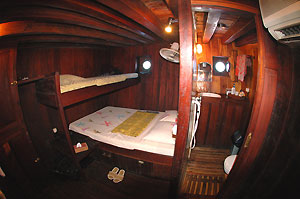 Bira or Kendari in Sulawesi, Maumere in Flores, Bima in Sumbawa or Sorong in West Papua, and the duration of the trips are designed to dovetailwith available flight connections. Cruises last from 8 to 14 days and will usually include opportunities to go ashore to discover some of the unique cultures and wildlife to be found in the Indonesian archipelago... including the extraordinary Komodo
Bira or Kendari in Sulawesi, Maumere in Flores, Bima in Sumbawa or Sorong in West Papua, and the duration of the trips are designed to dovetailwith available flight connections. Cruises last from 8 to 14 days and will usually include opportunities to go ashore to discover some of the unique cultures and wildlife to be found in the Indonesian archipelago... including the extraordinary Komodo 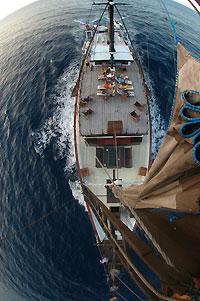 Dragon and Birds of Paradise.
Dragon and Birds of Paradise.
The Ondina has gone all out to provide comfort for the select few that cruise with this fine traditional Pinisi Schooner. Her cabins are very well appointed, the dive deck is known as being one of the best, with special camera counters and staff that know how to take care of you and your gear. Nitrox and E6 processing available.
Full Boat Dive Charters
For groups, the Ondina can be chartered and itineraries can be personalised to suit your group needs, likings or skills. In this case, book early before she already has other commitments! Depending on where you wish to sail and 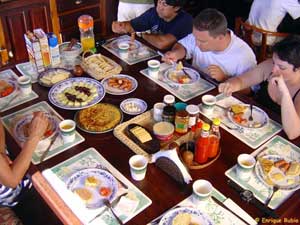 dive, there may be a charge for relocation to/from her original port of embarkation.
dive, there may be a charge for relocation to/from her original port of embarkation.
Non-Diving Charters
We can also arrange non-diving Cruises. The are many wonderful routes to be enjoyed in Indonesia without diving: Paradise beaches, fishing villages, island hopping, National Parks, traditional rituals and millenary ceremonies will make the best frame for a well deserved exotic holidays.
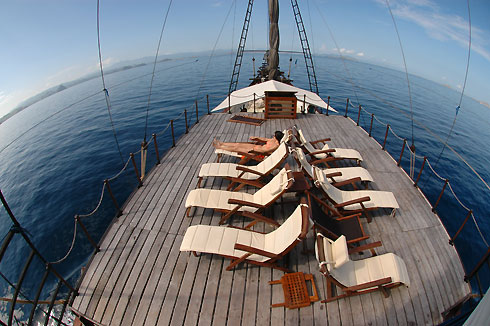
Boat Information
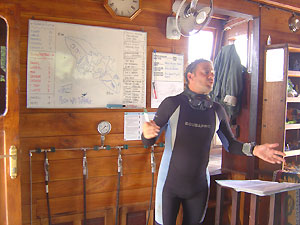 Name : SMY Ondina
Name : SMY Ondina- Destination : Indonesia
- Seasons : Year around
- Capacity : 16 maximum (max no. guests)
About the cabins
- Cabin Facilities Room : 8 double cabins with air conditioning and en suite bathrooms
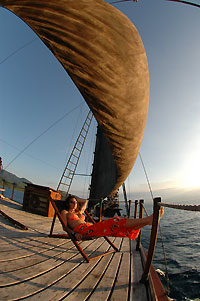 Electricity : 220V
Electricity : 220V- Sockets:
Technical Data
- Length x Beam : 32 x 8 metres
- Engines : 400Hp MAN Medium Duty
- Max speed :
- Cruising speed : 9 knots
- Navigation equipment : VHF Radio with Global Maritime Distress Signal System (GMDSS), SSB Radio, ICOM VHF hand sets
- Communications equipment : ERICSSON R190 Telephone: Access South East Asia Satellite and GSM
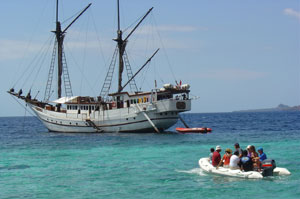 Fuel capacity/range : 12Tn
Fuel capacity/range : 12Tn- Fresh water capacity : 10Tn
Further Information
- Dive Entry : 3 dinghies: 2 semirigid and 1 rigid with 40 and 25 HP YAMAHA engines
- Life jackets : 2 Solas Life Rafts for 30 pax
- Life rafts : Yes
- Boat Crew : Captain, Cruise Director, Dive Master, 3 sailors, engineer + assistant, cook, 2 service staff and a masseuse
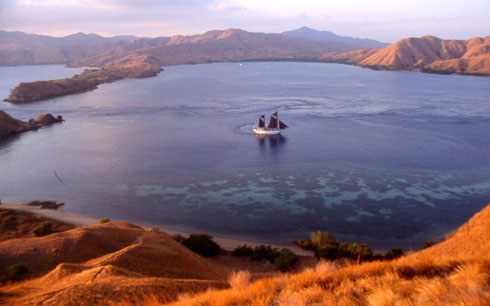
The Raja Ampat Agressor
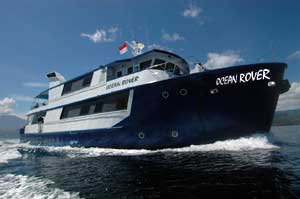 Formerly known as the Ocean Rover, The Raja Ampat Agressor is a purpose built, luxury, live aboard vessel built in Phuket by a team of divers looking for the perfect dive vessel. She was launched in August 2000 and then relocated to North Sulawesi in June 2008.
Formerly known as the Ocean Rover, The Raja Ampat Agressor is a purpose built, luxury, live aboard vessel built in Phuket by a team of divers looking for the perfect dive vessel. She was launched in August 2000 and then relocated to North Sulawesi in June 2008.
The Agressor was designed for comfortable and safe offshore diving. Her thick steel hull is 100 ft/30 m long and 26 ft/8 m wide. She is powered by three Hino 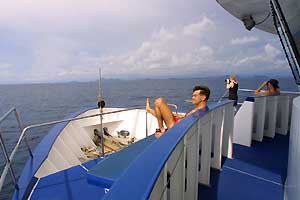 V10 420 Hp diesel engines, driving three propellers for extra safety. Her cruising speed is 10 knots and the top speed 12.5, allowing us to visit many far-flung dive sites in one single cruise.
V10 420 Hp diesel engines, driving three propellers for extra safety. Her cruising speed is 10 knots and the top speed 12.5, allowing us to visit many far-flung dive sites in one single cruise.
Raja Ampat Agressor takes a maximum of sixteen passengers in eight cabins which are all located on the main and upper decks. There are no guest cabins below decks so there are 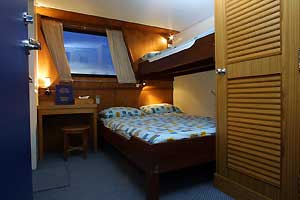 no loud annoying engine room noises! Six cabins feature large double beds with single upper berths and large panoramic windows. The two forward cabins feature wide upper and lower berths and have dual portholes. All cabins have private en-suite bathrooms, individually controlled AC and lots of storage space.
no loud annoying engine room noises! Six cabins feature large double beds with single upper berths and large panoramic windows. The two forward cabins feature wide upper and lower berths and have dual portholes. All cabins have private en-suite bathrooms, individually controlled AC and lots of storage space.
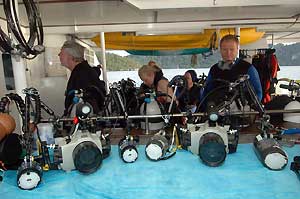 The huge dive-deck has several camera tables and rinse tanks. Care has been taken to ensure that photographers have safe places to put down their expensive cameras just before and after the dive. The Agressor’s unique feature is the “Whale-Deck”: The lower section of the dive deck which slopes down to the waterline allowing for optimum ease of diving operations. This “Whale-Deck” is where the
The huge dive-deck has several camera tables and rinse tanks. Care has been taken to ensure that photographers have safe places to put down their expensive cameras just before and after the dive. The Agressor’s unique feature is the “Whale-Deck”: The lower section of the dive deck which slopes down to the waterline allowing for optimum ease of diving operations. This “Whale-Deck” is where the 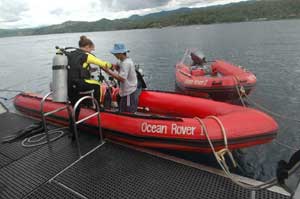 zodiacs are stored when the vessel is underway.
zodiacs are stored when the vessel is underway.
The spacious salon offers a comfortable dining and sitting arrangement, fully equipped entertainment centre and a camera charging area with 220/110 V connections. The interior has been kept light and airy and has a relaxed atmosphere. The salon has a fully stocked refreshments corner and our extensive marine life library. A 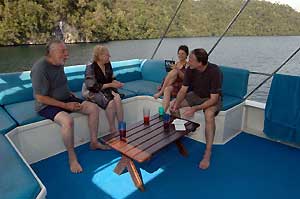 camera maintenance room is kept there as well.
camera maintenance room is kept there as well.
The aft upper deck or sun-deck is partly shaded and is everyone’s favourite area for relaxing and socialising between dives. A second fully stocked refreshments corner is located there, including an ice maker and a second refrigerator. Passengers can sit around the large picnic style table or settle down on one of our comfortable 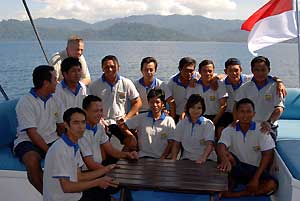 lounge chairs.
lounge chairs.
Raja Ampat Agressor's 16 passengers are cared for and pampered by 14 highly motivated and well trained crew members.
Raja Ampat Agressor's areas of operation are North Sulawesi, the Sangihe Archipelago and Raja Ampat in the East of Indonesia.
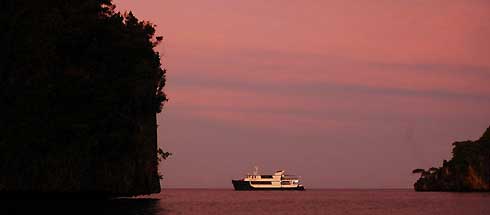
The Tambora
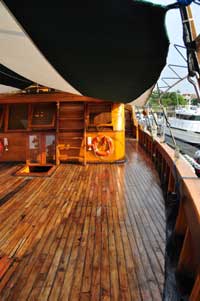 Tambora was built by traditional boat builders on the Indonesian island of Sulawesi, in the centuries-old tradition of a wooden Phinisi. The design and materials used guarantee immense strength and resilience of all key structural elements, especially the keel, hull and decks. Slight adjustments have been made to the original design, which was geared rather for cargo ships ferrying goods and commodities across the Indonesian archipelago, as compared to a modern liveaboard carrying passengers. Among others, they include a double keel and relatively smaller beam, to minimize rolling of the vessel in heavy seas.
Tambora was built by traditional boat builders on the Indonesian island of Sulawesi, in the centuries-old tradition of a wooden Phinisi. The design and materials used guarantee immense strength and resilience of all key structural elements, especially the keel, hull and decks. Slight adjustments have been made to the original design, which was geared rather for cargo ships ferrying goods and commodities across the Indonesian archipelago, as compared to a modern liveaboard carrying passengers. Among others, they include a double keel and relatively smaller beam, to minimize rolling of the vessel in heavy seas.
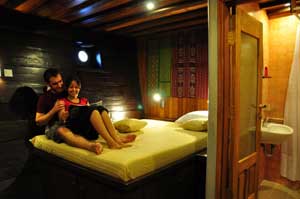 Tambora has been entirely constructed out of iron wood and chosen Javanese teak. While her hull has been painted white, the superstructure, decks and roofs have all been finished with a view towards preserving the natural beauty of the teak wood. All decks and the salon rooftop feature teak parquet flooring. This way, the rustic charm and warmth of a traditional wooden vessel has been preserved. All guest suites and rooms on board have been designed by a renowned Indonesian interior designer, and built-to-design by an experienced interior architect.
Tambora has been entirely constructed out of iron wood and chosen Javanese teak. While her hull has been painted white, the superstructure, decks and roofs have all been finished with a view towards preserving the natural beauty of the teak wood. All decks and the salon rooftop feature teak parquet flooring. This way, the rustic charm and warmth of a traditional wooden vessel has been preserved. All guest suites and rooms on board have been designed by a renowned Indonesian interior designer, and built-to-design by an experienced interior architect. 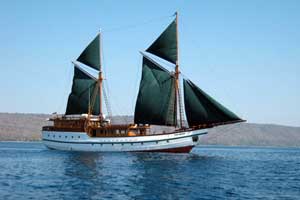 Guest suites are well appointed and tastefully designed in a perfect blend of traditional Indonesian motifs and modern functionality.
Guest suites are well appointed and tastefully designed in a perfect blend of traditional Indonesian motifs and modern functionality.
The traditional Phinsi-style arrangement of the sails has been kept unchanged. Experiencing Tambora under sails, with a good wind blowing, is an amazing sight and a great way to travel through the Indonesian islands.
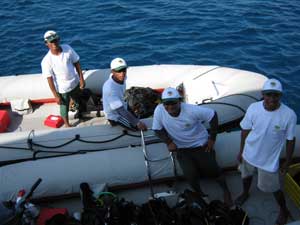 Great care has been taken to optimally combine the space and atmosphere on deck with the activities of liveaboard diving. Dinghies are equipped with customised racks to store diver’s gear in between dives; tanks do not need to be carried back and forth but can be re-filled directly on the dinghies. At night and during longer periods of sailing, all gear is stored away from the elements in the dive station. No dive gear is left sitting around on deck.
Great care has been taken to optimally combine the space and atmosphere on deck with the activities of liveaboard diving. Dinghies are equipped with customised racks to store diver’s gear in between dives; tanks do not need to be carried back and forth but can be re-filled directly on the dinghies. At night and during longer periods of sailing, all gear is stored away from the elements in the dive station. No dive gear is left sitting around on deck.
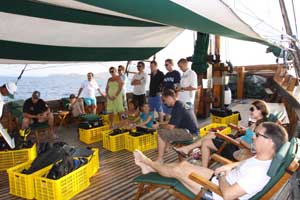 Spacious ...
Spacious ...
Tambora has been sized and configured to comfortably accommodate a maximum of 16 divers:
- Eight spacious guest suites, each at least 15m2 in size, and with a large en-suite bathroom
- Choice of double and large twin beds (no bunk beds!)
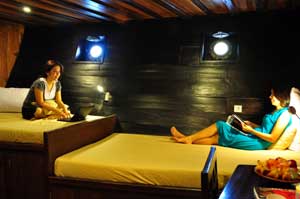 All beds longitudinally aligned with the vessel, so our guests sleep in the direction of the vessel movement
All beds longitudinally aligned with the vessel, so our guests sleep in the direction of the vessel movement- Each guest suite comes with a writing desk. If you like, you can fill in your logbook or review the shots from the day’s diving in the privacy of your own suite
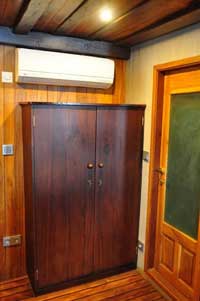 Ample storage space for clothes, bags, books, magazines, etc.
Ample storage space for clothes, bags, books, magazines, etc.- Large salon with separate dining and relaxing sections, offering enough space during mealtimes, as well as for chilling out over a chat and drinks with fellow divers, with a book in your hands, or working on your laptop
- Three separate lounge decks – bow, aft and salon rooftop – provide enough space and privacy, and can be fully shielded from the sun
Well appointed ...
Guest suites and the large salon make life on board as easy as possible:
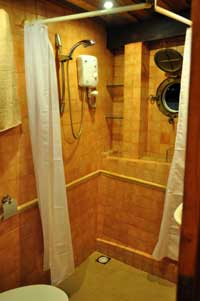 Showers in all en-suite guest bathrooms come with individually adjustable hot and cold water
Showers in all en-suite guest bathrooms come with individually adjustable hot and cold water- Separate shower and hand towels for each guest
- Each guest suite comes with a writing desk. So if you like, you can fill in your logbook or review the shots from the day’s diving in the privacy of your own suite
- All guest suites are equipped with individually controllable air conditioning
- Individual reading lights above each bed
- Plenty of power outlets (European 220V type) in your suite and throughout the vessel
- 2-4 portholes per guest suite for natural light, as well as a fresh sea breeze when opened!
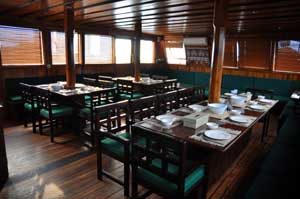 The large salon is well ventilated at most times, but also has its own air conditioning for those rainy days
The large salon is well ventilated at most times, but also has its own air conditioning for those rainy days- Large flat screen TV/DVD with home cinema surround sound in the salon
- Satellite-based communication for phone calls, your personal email and internet access
Quiet ...
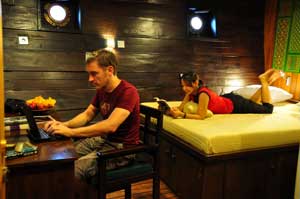 Noise – as such, or as a consequence of excessive vibration – can seriously spoil life on board. Noise has also been proved to contribute to fatigue and seasickness. Tambora has been designed and built to keep excessive noise under control:
Noise – as such, or as a consequence of excessive vibration – can seriously spoil life on board. Noise has also been proved to contribute to fatigue and seasickness. Tambora has been designed and built to keep excessive noise under control:
- Throughout the entire vessel, separating walls have been soundproofed with noise absorbing materials. This helps mitigate noise, as well as guarantee the privacy of our guest suites
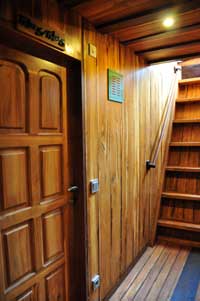 Engine room bulkheads are extra thick to absorb engine noise
Engine room bulkheads are extra thick to absorb engine noise- Similarly, all ceilings and decks have been soundproofed to mitigate step noise
- Tambora’s power train employs a flexible coupling to reduce vibration and thus structure-borne noise
- Her five-blade propeller is made of a special, very stiff alloy, minimizing internal vibration of the blades which are a key source of structural noise
- All engines under deck sit on flexible, shock-absorbing mountings
- Our “silent” water-cooled air conditioning system does not need noisy radiator fans
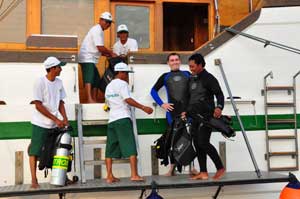 Cool ...
Cool ...
Among the natural luxuries of travelling at sea is enjoying the breezes when sitting out on deck. Conversely, inside a vessel, and especially under deck, temperatures can be too hot for comfort. Wherever possible, Tambora has been designed to mitigate this:
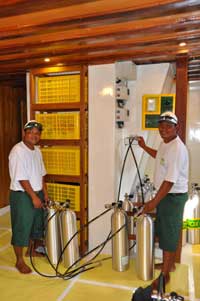 All ceilings and decks have been thermally insulated, to prevent the rooms underneath from heating up under the intense tropical sun
All ceilings and decks have been thermally insulated, to prevent the rooms underneath from heating up under the intense tropical sun- Tambora’s hull is painted white to reflect sunlight. As trivial as it sounds, this makes a huge difference to temperatures inside!
- All guest suites as well as the large salon feature individually controllable air conditioning
Savory ...
- Tamboda's Chef serves a menu of tasty Indonesian, European and Japanese specialties, freshly prepared in the boat's well-equipped kitchen. Five meals a day mean there is a tasty bite awaiting you when you surface.
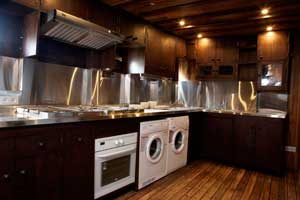 Snack prior to the first dive of the day: coffee, tea, fruit juice, milk, toast, selection of biscuits
Snack prior to the first dive of the day: coffee, tea, fruit juice, milk, toast, selection of biscuits- Breakfast after the first dive: choice of omelet, scrambled eggs, bacon and eggs, pancakes; also toast, marmalades, and fruits, served with coffee, tea, fruit juices, milk and soft drinks
- Lunch: served, soup and main course, kept rather light!
- Afternoon snack after the third dive of the day: variation of cakes, fruits, and Indonesian specialties, with coffee and tea
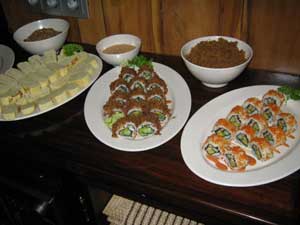 Dinner: buffet-style, with a different theme every evening
Dinner: buffet-style, with a different theme every evening- Drinks are on a help-yourself basis available in the salon: drinking water, a broad selection of local coffees, tea, milk, a range of soft drinks soft drinks and beer are all included in the cruise fare
- Wine and liquor are charged on a separate basis
Lowest Possible Carbon Emissions
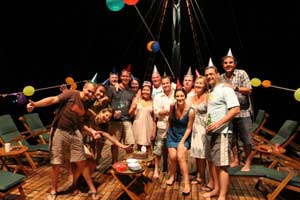 For the time being, there is no way to operate a ship like Tambora without burning fossil fuels – by the ships’ main engine, to thrust the ship forward when there is not enough wind, and by its auxiliary engines to generate the electric power required to illuminate rooms and cabins, keep food fresh, prepare meals, fill dive tanks, and many others. While the usage of diesel cannot (yet) be avoided, Tambora's crew go to length to keep it as low as possible. This means lower carbon emissions into the atmosphere. It also means no need for fuel surcharges.
For the time being, there is no way to operate a ship like Tambora without burning fossil fuels – by the ships’ main engine, to thrust the ship forward when there is not enough wind, and by its auxiliary engines to generate the electric power required to illuminate rooms and cabins, keep food fresh, prepare meals, fill dive tanks, and many others. While the usage of diesel cannot (yet) be avoided, Tambora's crew go to length to keep it as low as possible. This means lower carbon emissions into the atmosphere. It also means no need for fuel surcharges.
Tambora’s propulsion system has been engineered for maximum fuel efficiency. At the heart is a new, genuine marine engine, which is significantly lower on fuel consumption. The five-blade propeller has been custom-designed and fabricated from a special, stiffer alloy, minimising power losses due to both internal vibration and unnecessary slip.
The electrical system, too, has been designed end-to-end with a view towards maximum fuel efficiency, including:
- A range of genuine marine and industrial power generators with different output, allowing us to always choose the most suitably sized engine under different load conditions
- Capacitor banks to smooth power needs and curb peaks
- Over-sized marine cabling throughout the entire vessel, resulting in lower distribution losses
- The exclusive usage of power saving lighting throughout the entire vessel; searching for a conventional light bulb is a futile exercise on Tambora!
- The thermal insulation of all decks and ceilings, and the usage of a white, reflecting paint on the outer hull above the waterline, avoids the vessel’s interior from heating up too much under direct sunlight, so that air conditioners do not need to run so hard to keep temperatures comfortable


